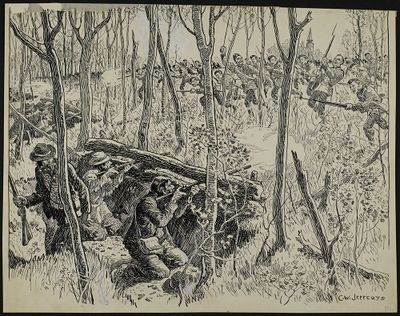Annotation:Road to Batoche: Difference between revisions
No edit summary |
No edit summary |
||
| Line 10: | Line 10: | ||
<div style="text-align: justify; direction: ltr; margin-bottom: 90px; margin-left: 70px; margin-right: 120px;"> | <div style="text-align: justify; direction: ltr; margin-bottom: 90px; margin-left: 70px; margin-right: 120px;"> | ||
<br> | <br> | ||
'''ROAD TO BATOCHE, THE.'''' Canadian, Reel (cut time). E Dorian. Standard tuning (fiddle). Attributed to Métis fiddler Andy DeJarlis (Manitoba). The Métis are Native Americans of mixed English, French and Native American descent, who were originally trappers and woodsmen involved in the fur trade in the 19th century, where they came in contact with the music of British traders and storekeepers. The Métis fiddling tradition retains both Scottish and French elements in a Native American context, and tunes are improvisational and often irregular. [[File:batoche.jpg|400px|thumb|right|Bayonet charge at the Battle of Batoche]] | '''ROAD TO BATOCHE, THE.'''' Canadian, Reel (cut time). E Dorian. Standard tuning (fiddle). Attributed to Métis fiddler Andy DeJarlis (Manitoba). The Métis are Native Americans of mixed English, French and Native American descent, who were originally trappers and woodsmen involved in the fur trade in the 19th century, where they came in contact with the music of British traders and storekeepers. The Métis fiddling tradition retains both Scottish and French elements in a Native American context, and tunes are improvisational and often irregular. DeJarlis's recording has tom-tom drumming introducing and ending the tune. [[File:batoche.jpg|400px|thumb|right|Bayonet charge at the Battle of Batoche]] | ||
<br> | <br> | ||
<br> | <br> | ||
Revision as of 21:58, 12 February 2018
X: 2 T: Road To Batoche R: barndance M: 4/4 L: 1/8 K: Edor |:E2B,2 E3F|G3A B2AG|FEDF AFDF|ABAG FEDF| E2B,2 EDEF|GFGA B2 AG|FEDF ABAG|FEDF E4:| |:B2 ee e2 ef|geaf gfec|d2 fd ABde|fdfd edBA| B2 ee e2 ef|geaf gfec|d2 fd ABAG|FGAF E4:|

Batoche was the provisional capital declared during the Northwest Rebellion of 1885, led by Louis Riel (1844-1885), who had hoped to unite Métis, Cree and Anglo settlers in an independent state. Riel had originally been elected to articulate their grievances to the Canadian government, but instead chose to try a military solution. His united front never materialized, however, and became largely a rebellion of the Métis and Cree. After some initial victories Riel and his forces were defeated in the Battle of Batoche, north of what is now Saskatoon, Saskatchewan. Riel was captured and executed in November, 1885, by the Canadian government of Prime Minister John A. MacDonald.
